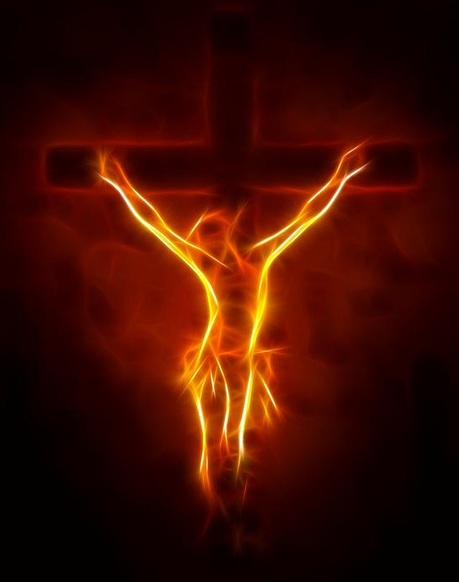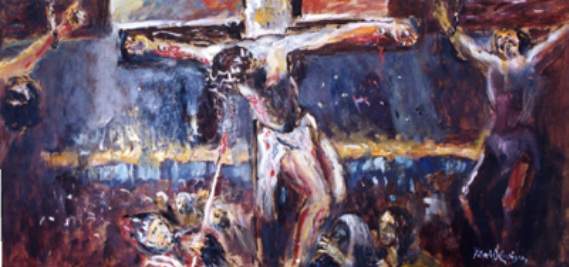A L I F E L A I D D O W N
by Jeremy Chance Springfield
The crucifixion of the Messiah shows that man is loved by the Creator with a love that cannot be properly comprehended. It is a pervasive, fierce affection redefining the meaning of devotion. In all honesty, it is a terrifying display of the passion He holds for His image-bearers. The horror and hate of the cross is bearable only by the reality that it is overshadowed by the love of the Father for us.
To meditate on the cross is an exercise in appreciating how serious the Holy One takes the redemption of men. His Son was woven into the womb of a woman of high virtue, wrapped in familiar flesh and blood, birthed into a society that longed for Him with fervent desire; a people who were His very kin, and who ultimately ushered Him with sincere and hateful malice to the very door of death. All this His Son so obediently accepted in order to buy men back from the grave.
It was no accident that He died at the hands of those He loved.
It was no impossible escape that loomed before Him.
The Son, Yeshua, went willingly to His death.
We can all accept that historical fact, can’t we? There’s no disagreement in such a thing. He was brutally treated by those who had prayed daily for His advent and coronation as King. Hate-filled hearts condemned Him to die a death of shame and utter anguish. Hatred is a powerful impetus, and yet, in all their hatred, they could only go so far in their desire to kill the promised Messiah. They could only condemn; they could not carry it out.
Hate is a four-letter word. It is a vile thing, a vehicle for raw emotion. But it has limits.
Love is a four-letter word, and it, too, is a vehicle for raw emotion. But unlike hate, love has no limits. There are no true boundaries for what love can accomplish.
Hate is a four-letter word. It is a vile thing, a vehicle for raw emotion. But it has limits.
Love is a four-letter word, and it, too, is a vehicle for raw emotion. But unlike hate, love has no limits. There are no true boundaries for what love can accomplish.
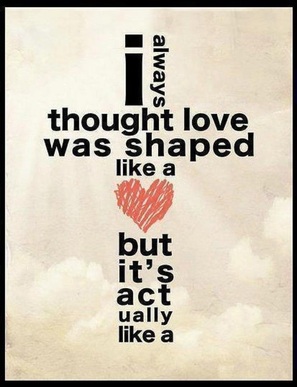
The cross, as hateful an ordeal as it was for the Messiah, could be endured because it was not founded on the hate of those who sent Yeshua into its arms, but on the love that was propelling the Son to the cross and beyond, in order that man might once again be embraced by the arms of the Holy One, blessed be He. To be sure, hate played a very real role in placing Messiah upon the cross, but that is as far as hate could take Him. Love picked up the reigns and did what hate could not do. Love killed the Son of the Holy One.
Several times in the New Covenant writings, we find that Messiah speaks of His intended purpose to give His life away, to lay it down. Matthew 20:27-28 records the first instance of such a declaration:
And he who desires among you that he should be first should be for you a servant, even as the Son of Man did not come that He should be served, but instead, that He should serve, and that He should give His soul a ransom for many.
This same account is repeated in Mark 10:45. He comes to serve, and in serving, gives His life away. He gives it. None took it. None could take it. By the very nature of who He is, no person could legally take His life. Death comes only by sin, and without sin, death has no rights. Upon the cross, He had to willingly submit Himself to the destruction that comes from sin.
For He that did not know sin, on your account was made sin, that we should become in Him the righteousness of Alaha.
~ 2nd Corinthians 5:21
For there is not for us a Great Priest who is unable to suffer with our weakness, but rather, He was tempted in every thing like us -- apart from sin.
~ Hebrews 4:15
He had to willingly give up His life because, being naturally without sin, death could not touch Him. It had to be laid down. He says this with even more clarity in another instance, and removes all doubt as to how powerful love is when lived out by the Son of the Highest. In the book of John chapter 10, we find several verses where He makes abundantly clear how far His divine authority reached:
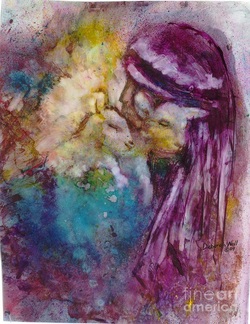
I am the good Shepherd, and the good Shepherd lays down His soul for His flock.
(verse 11)
I am the good Shepherd, and I know My own, and I am known of My own, even as My Father knows Me, and I know My Father, and My soul I lay down for the flock.
(verse 14-15)
On account of this My Father has compassion on Me: that I lay down My soul, and again receive it. There is no man taking it from Me, but instead, I lay it down from My willingness; for I have the authority that I should lay it down, and I have the authority that I should again receive it. This commandment I have accepted from My Father.
(verse 17-18)
Do you believe He has that authority? No man took His life. No man had such authority. Only Messiah possessed the authority to lay down His life unto death. It was a commandment given to Him by the Father, and He accepted that commandment.
He did not die on the cross due to the vile administrations of man overpowering Him. Yeshua gave up His life. He willingly released His Spirit from His body.
He forced Himself to die.
He did this out of love. Love took the life of the Messiah.
It is difficult to imagine this, even with the verses above telling us as much, therefore, consider the events surrounding His death, and note well that they align perfectly, and somewhat terrifyingly, to such an astonishing truth. All four accounts of the crucifixion record Messiah’s last moments. All four speak of Him crying out a final statement before dying. All four also note the reaction of the soldiers responsible for physically crucifying Yeshua. All four make mention of their surprise at what happened.
(verse 17-18)
Do you believe He has that authority? No man took His life. No man had such authority. Only Messiah possessed the authority to lay down His life unto death. It was a commandment given to Him by the Father, and He accepted that commandment.
He did not die on the cross due to the vile administrations of man overpowering Him. Yeshua gave up His life. He willingly released His Spirit from His body.
He forced Himself to die.
He did this out of love. Love took the life of the Messiah.
It is difficult to imagine this, even with the verses above telling us as much, therefore, consider the events surrounding His death, and note well that they align perfectly, and somewhat terrifyingly, to such an astonishing truth. All four accounts of the crucifixion record Messiah’s last moments. All four speak of Him crying out a final statement before dying. All four also note the reaction of the soldiers responsible for physically crucifying Yeshua. All four make mention of their surprise at what happened.
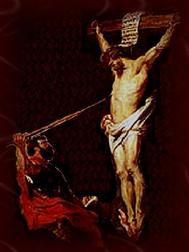
In order to better appreciate the details surrounding His death, and how they support the macabre idea of Yeshua literally giving up His life, one must understand a few gruesome aspects of what crucifixion would physically do to a person. Everybody is aware of the nails in the feet and hands, but more happened inside the person in that event than is able to be considered when images of the cross are depicted.
With the individual’s feet nailed to the wood, and their arms suspended also to the cross-beam, all the weight of the person would be naturally imposed upon the nails in the feet, causing enormous amounts of pain. However, to relieve such pressure, the crucified individual would need to use the muscles in their arms to lift themselves up slightly, pulling down on the nails in their hands. This strain on the arms could only go on for so long, before weakness set in and rendered them useless in aiding in the relief on the legs. When that happened, the feet would support entirely the weight of the individual, causing severe pain, but also the beginning of a process that could easily lead to death: positional asphyxia.
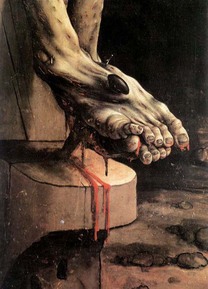
In positional asphyxia with regards to a crucifixion, the weight of the individual, combined with the stress on the upraised arms, necessitated that the intercostal muscles of the chest, those that mechanically cause the rib cage to expand and retract during the process of inhalation and exhalation, would be stretched into an inhalation state when the weight of the individual was solely on the legs. Such position would make it essentially physically impossible for a person to exhale once they had inhaled in that position. The only way to exhale would be to place pressure even more on the feet and lift them up against the upright stake, allowing their intercostal muscles to retract, and aide the lungs in releasing the breath. Failure to use the legs in this manner would lead to positional asphyxia, that is, the lungs would slowly fill with fluids because the gases taken in during inhalation could not be properly processed and released. Speech would become increasingly difficult and harder to understand, due to the lungs filling up.
With this understanding in place, we see that Messiah’s words were misunderstood by many just before His death. While He cried out to Elohim, others thought He was calling to Elijah, due to the difficulty in properly enunciating words that resulted from the physical processes at work in His body. He was drowning before His persecutors.
After He cried out His last words, He breathed His last, and died. This is where the reactions of the soldiers become so significant. Every account mentions that they took note of His death, but only one gives a unique witness about a key event that brings it all together. John 19:31-35 gives the account in context:
Yet, the Jews, on account that it was evening, they had said, “Do not let remain these bodies upon their crosses, on account that the Sabbath day dawns.” For that day was a high day of the Sabbath. And they requested from Pilate that the shin-bones should be broken of those crucified, and they should be let down. And the soldiers, they came, and they broke the shin-bones of the first, and those of the other who was crucified with him. And when they came unto Yeshua, they saw that He was already dead, and they did not break His shin-bones. Instead, one from the soldiers struck at His side with the spear, and immediately there came out blood and water. And he who saw has testified, and his testimony is true, and he knows that he speaks the truth that you also should believe.
The request to break the shin-bones of the crucified individuals, despite how painful and ghastly, was of a degree of mercy, for death would be swifter if the legs could not be relied upon to lift the body up enough to draw another breath, releasing the lungs from the threat of positional asphyxia. Otherwise, with full use of the legs, crucifixion could be endured for days on end, until blood loss, infection, and exhaustion set in upon the crucified individual. Broken legs meant a quick death.
The reader is asked to now consider the horror and power of love. Messiah’s legs were not broken. He should have been alive. He should have first required the breaking of His legs to properly expire, like His fellow condemned. The fact that He was already dead at this early time, coupled with His former statements that He alone would give up His life, that He alone had the authority to lay it down, brings us to a truly sobering reality: Yeshua refused to use His legs to lift His body up the few inches required to prevent the processes of positional asphyxia from taking their toll in His lungs.
After He cried out His last words, He breathed His last, and died. This is where the reactions of the soldiers become so significant. Every account mentions that they took note of His death, but only one gives a unique witness about a key event that brings it all together. John 19:31-35 gives the account in context:
Yet, the Jews, on account that it was evening, they had said, “Do not let remain these bodies upon their crosses, on account that the Sabbath day dawns.” For that day was a high day of the Sabbath. And they requested from Pilate that the shin-bones should be broken of those crucified, and they should be let down. And the soldiers, they came, and they broke the shin-bones of the first, and those of the other who was crucified with him. And when they came unto Yeshua, they saw that He was already dead, and they did not break His shin-bones. Instead, one from the soldiers struck at His side with the spear, and immediately there came out blood and water. And he who saw has testified, and his testimony is true, and he knows that he speaks the truth that you also should believe.
The request to break the shin-bones of the crucified individuals, despite how painful and ghastly, was of a degree of mercy, for death would be swifter if the legs could not be relied upon to lift the body up enough to draw another breath, releasing the lungs from the threat of positional asphyxia. Otherwise, with full use of the legs, crucifixion could be endured for days on end, until blood loss, infection, and exhaustion set in upon the crucified individual. Broken legs meant a quick death.
The reader is asked to now consider the horror and power of love. Messiah’s legs were not broken. He should have been alive. He should have first required the breaking of His legs to properly expire, like His fellow condemned. The fact that He was already dead at this early time, coupled with His former statements that He alone would give up His life, that He alone had the authority to lay it down, brings us to a truly sobering reality: Yeshua refused to use His legs to lift His body up the few inches required to prevent the processes of positional asphyxia from taking their toll in His lungs.

The blood and water that flowed from His side, witnessed by the soldier who pierced Him, shows that He had died from positional asphyxiation. The blatant witness of the soldier of this unique event is powerful evidence of the physical reality that had happened in the body of Yeshua. The soldier was astonished at what he saw and wished to testify of it, because He knew Messiah’s legs weren’t broken, and yet the normal signs of positional asphyxiation were vividly present in Yeshua, which should not have been the case after just a few hours on the cross. He apparently realized immediately that something essentially unbelievable had happened with Yeshua’s crucifixion. He was so amazed that he wanted followers of Messiah to know the grim facts so they could understand Messiah intentionally purposed to lay down His life when He was otherwise physically not yet in the dying process.
Meditate on this.
He did not fail in strength. He knew no weakness of mind. With sheer willpower, with a perfect and terrifying determination, the Son of the Holy One held full control over the screaming desire of every cell in His body crying out to continue, every cell that only knew life, every cell that craved for just one more breath. He forced Himself to refrain from using the capable muscles and bones of His legs to raise Himself up to relieve the anguishing pressure in His lungs. He had received and accepted the commandment from the Father to do this very act. He would not fail. His victory was in an intentional defeat. He ordered every nerve firing to every muscle to remain solely at His command, and in doing so, truly laid down His life.
He died on purpose.
More than we can ever rightly understand.
In full authority of His mind and His body, He showed us that love was ruling from the throne of the cross. Hate did not triumph. This King reigned like no other before or since, and the souls of men were ransomed.
Love that is greater than this there is none: that a man should lay down His soul for his friends.
~ John 15:13
Meditate on this.
He did not fail in strength. He knew no weakness of mind. With sheer willpower, with a perfect and terrifying determination, the Son of the Holy One held full control over the screaming desire of every cell in His body crying out to continue, every cell that only knew life, every cell that craved for just one more breath. He forced Himself to refrain from using the capable muscles and bones of His legs to raise Himself up to relieve the anguishing pressure in His lungs. He had received and accepted the commandment from the Father to do this very act. He would not fail. His victory was in an intentional defeat. He ordered every nerve firing to every muscle to remain solely at His command, and in doing so, truly laid down His life.
He died on purpose.
More than we can ever rightly understand.
In full authority of His mind and His body, He showed us that love was ruling from the throne of the cross. Hate did not triumph. This King reigned like no other before or since, and the souls of men were ransomed.
Love that is greater than this there is none: that a man should lay down His soul for his friends.
~ John 15:13
All study contents Copyright Jeremy Chance Springfield, except for graphics and images, which are Copyright their respective creators.
